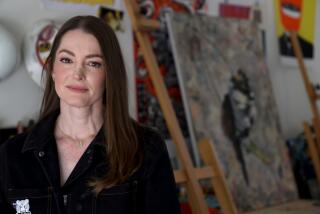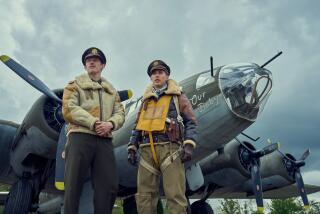Prop Jets : Pacoima Firm Finds Its Niche in Airplane Mock-Ups for Film and TV
- Share via
In Alfred Hitchcock’s 1966 thriller “Torn Curtain,” Alf Jacobsen plays a ship steward delivering a radiogram to scientist Paul Newman.
Five minutes into the movie, Jacobsen disturbs Newman and his fiancee, played by Julie Andrews, in their cabin with a knock on the door and hands Newman a slip of paper with a mysterious message on it. One minute and 10 words later, Jacobsen’s part ends.
Jacobsen, who acted under the name Burt Brandon, gets a lot more movie action these days. Airline Film & TV Promotions, a Pacoima company he owns with partner Byron W. Schmidt, is Hollywood’s main non-studio provider of mock-ups of 747s, DC-10s and other airline-related equipment used by directors in commercials, television shows and films.
Airline Film and TV is in a business in about as narrow a niche as they come. Few airlines use their planes even for their own commercials, and for other entertainment projects filming on an actual plane tends to be clumsy and often prohibitively expensive. Grounding a single jumbo jet can cost an airline as much as $150,000 a day in lost revenue. So directors usually film inside of mock-ups such as the ones owned by Jacobsen and Schmidt. They also use a fake ticket counter and boarding gate Jacobsen and Schmidt have in the warehouse, and sometimes buy file footage of airliners from them.
Daily Rate
Jacobsen and Schmidt charge a daily rate of $2,500 to $4,000, depending on the type of mock-up being used. The cost is less on days when film crews and designers are setting up scenes than on days when actual filming occurs.
The airliner mock-ups in their warehouse resemble wooden skeletons of planes without wings or tails. The cabin of their mock 747 is about 30% the size of a real one. Inside, it resembles a real airliner, with such touches as movie screens that can be hung from the front of the cabin, kitchens, restrooms and a spiral staircase inside of the first-class section. Various production tricks can be used to make “sky” show through the windows.
“To the camera eye, it is absolutely realistic. You can’t tell the difference,” said Bill Alenson, an advertising executive with United Airlines, which frequently uses Airline Film and TV’s warehouse to film commercials.
Sometimes filming resembles real life as well. Jacobsen and Schmidt recalled that one extra in a television series two years ago needed an airsick bag after he and the other extras were asked to pretend they were being tossed around by turbulence.
1,000 Commercials
Jacobsen and Schmidt estimate that since forming their company in 1974, their mock-ups have been used in 1,000 commercials, 250 television shows and 100 feature films. The company has grown to about $700,000 a year in sales.
Recent films that have used their equipment include “Midnight Run” with Robert De Niro and Charles Grodin and “Planes, Trains and Automobiles,” a comedy starring Steve Martin and John Candy. Last month, NBC aired the television movie “The Taking of Flight 847: The Uli Derickson Story” starring actress Lindsay Wagner in the story of the 1985 TWA hijacking in Greece. A large part of the film was shot at a studio using an Airline Film and TV mock-up, which was disassembled and hauled by truck to the studio.
The company’s Pacoima warehouse also contains equipment used in some memorable Hollywood scenes. The fake cockpit used in producer Howard Koch’s “Airplane!” comedies sits in the warehouse. Jacobsen and Schmidt helped ready the cockpit mock-ups for the two films, “Airplane!” in 1980, with Kareem Abdul-Jabbar as the co-pilot, and “Airplane II: The Sequel,” in 1982.
In one part of the warehouse is a mock-up of an old Constellation airliner that Marilyn Monroe sat in during a scene in “How To Marry a Millionaire.” One of Fred Astaire’s last performances, an airline commercial with Gene Kelly, was filmed in one of their mock-ups.
Airline Film and TV Promotions is an outgrowth of a promotion business Trans World Airlines once operated in Van Nuys. In the 1950s and 1960s, TWA made available mock-ups to directors in exchange for plugs in movies, which explains why in so many film characters always flew TWA.
Jacobsen, 52, a native of Norway, and Schmidt, 64, a native of South Dakota, met while working for the TWA operation.
As an actor, Jacobsen said, he had plenty of roles, mostly small ones. He appeared in 248 television shows, including “Voyage to the Bottom of the Sea,” the “Batman” television series and “General Electric True,” a CBS show launched by Jack Webb in 1962 that lasted just 33 episodes. Jacobsen also appeared in five feature films. Schmidt was a marketing and promotions executive who went to work for TWA in the early 1950s soon after graduating from the USC.
The two men formed their company 15 years ago, initially working under contract to TWA and then going off on their own in 1979, the year they moved their operation to Pacoima. TWA is no longer involved in the mock-up business, and today Jacobsen and Schmidt own many of TWA’s old mock-ups.
To keep their equipment up-to-date, the two partners regularly attend auctions to bid on damaged or surplus airplane gear. They recently bought a row of coach-class airplane seats for $200, compared to about $7,000 for a new row.
The main reason the mock-ups are popular with directors and producers is control and cost.
‘Easy to Shoot’
“It’s very easy to shoot there,” Koch said. He said that although he has shot inside of a real plane before, he finds it easier and less costly to use facilities such as the one Jacobsen and Schmidt own.
Shooting at airports is still popular. Phillip Ewbank, superintendent of operations at Los Angeles International Airport and once LAX’s liaison with the film industry, said typically there are about five projects a week filming at the airport.
But it can be costly and, for some directors, troublesome. The basic costs of shooting at the airport can range from $1,000 to $5,000 daily, which includes such fees as a permit, paying for security guards and electricians and parking. An additional amount is usually paid when a specific airliner’s facilities are used.
But the biggest cost is insurance. To shoot in a plane can require an insurance policy for tens of millions of dollars in coverage. At LAX, the amount of insurance coverage required by the airport alone ranges from $500,000 for shooting outside a terminal away from the airfield to $4 million if they are shooting in an area where there are planes.
Security Problems
Another problem is noise and security--film crews must be watched so they don’t accidentally violate security. Loud noises can also happen at any time, although directors can often record dialogue again and insert it into a film.
Jacobsen and Schmidt said that as a result, directors and producers often find mock-ups the best alternative.
“I think Joe Public probably thinks it is real,” Jacobsen said. “I don’t think people conceive these things as mock-ups, except executives at studios, airline executives or directors because they know you can’t shoot some of these shots on a regular plane.”
More to Read
Inside the business of entertainment
The Wide Shot brings you news, analysis and insights on everything from streaming wars to production — and what it all means for the future.
You may occasionally receive promotional content from the Los Angeles Times.










